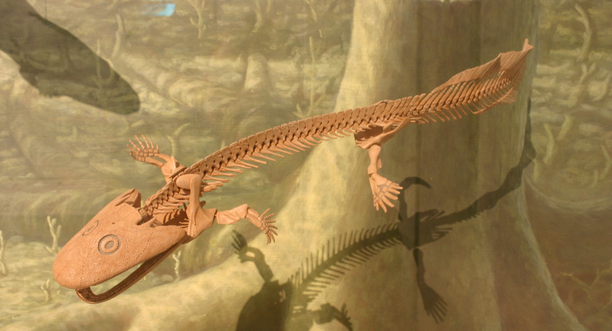A Distressingly Large Numbers of Fingers
Name: Acanthostega gunnari
Length: 2 feet
Weight: Unknown
Time Period: Late Devonian (Age of Fish), 360 million years ago
Location of Discovery: East Greenland
Acanthostega walks the thin line between a very derived fish and a very primitive amphibian. It very clearly possessed true, albeit webbed, feet attached to relatively long limbs. However, it also possesses many traits that indicate a primarily aquatic lifestyle, most notably eight digits on each hand and seven on each foot. This is a relic from the fins of its ancestors, the lobe finned fish group, and was a major surprise to the paleontologists who first found it. In addition to this, Acanthostega also had a fishlike spine and hip, small gills, and a lateral line (a line of exposed nerves along the sides of fish which detects motion and bio-electric pulse in the water). With all these fishlike traits it is clear that Acanthostega was not very amphibious at all, which lead paleontologists to wonder why it developed feet at all. The most prevalent theory is that it was a freshwater species that lived in rivers and lakes, and so used them to maneuver through fallen logs and other shallow water features. The fact that Acanthostega had small armored plates under the skin of its back seems to corroborate this theory, as they would have been used to prevent abrasions squeezing through rough crannies. It is believed it ambushed fish and small insects at and around the water’s edge, especially considering that there are similarities between its jaws and those of a crocodile.
